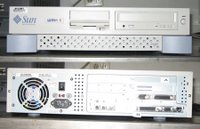Manufacturer: Apple Computer
Model: Macintosh SE/30
CPU: Motorola 68030, 16MHz
RAM: 64MB
HDD: 2x10GB SCSI
Release Date: January 1989
(Shown: my "Blackintosh" SE/30)
The Mac SE/30 lands itself nicely towards the more powerful end of the compact Mac spectrum. The pre-cursor to the compact Mac was the Apple Lisa, released in 1984. The Lisa was a foreshadowing of Apple's compact design. On the Lisa, Apple placed the drives to the right of the CRT instead of below it. What followed was a form factor that would remain largely unchanged for nearly ten years. Also Introduced in 1984 was the nearly un-usable Macintosh 128k. To the untrained eye, a vintage '84 Mac 128k and a Mac Classic II appear nearly identical, despite the last Classic II shipping out in October of 1993.
Like the SparcStation 5, the Mac SE/30 is another one of those rare gems that absolutely refuses to show its age. It's more portable than many of the "portable" computers of its time. Although it's capable of 1-bit monochrome graphics (black or white, no grays) or 256 grayscale with an expansion card (color with the card and external monitor) there really isn't a point to it.
With the help of Mode32, the SE/30 can operate in 32-bit mode, which makes it a perfect candidate for a UNIX variant. I usually choose NetBSD for 68k-based Macs. As a NetBSD machine with a text-only console, it provides a very robust and tolerable computing experience considering that the first SE/30s rolled off the assembly line almost two decades ago. It's capable of low-CPU tasks such as being a file and print server for a small office or home, providing centralized logging, or even for use as a network administration console when loaded up with pre-compiled tools from the NetBSD package system.
The Mac SE/30 has 8 slots for RAM. You must have Mode32 enabled before upgrading the SE/30 past 8MB of RAM or you might have problems. 4 RAM slots have to be loaded at the same time, so you must use 4 or all 8 slots. You can't use 2 slots or 6 slots.
One thing I did was attach a hard drive power splitter and longer SCSI cable. It's a tight fit, but I was able to squeeze two half-height SCSI drives into the case below the CRT. I also added an Asante NIC. The SE/30 was one of few compact Mac models to include an expansion slot on the back. The added touch of a network card is what makes this machine worthwhile.
In 1998, I took my SE/30 completely apart before painting the case a beautiful gloss black. I also painted the entire keyboard except for the very tops of the keys and sanded the old, sun-yellowed textured mouse and "programmer buttons" to a smooth, light grey finish. I took this machine with me to DefCon that year, and used it in Capture The Flag as my attack platform. I didn't win, but I turned quite a few heads. Most people didn't believe that it was a real SE/30 but thought it must be a 486 and greyscale monitor inside a compact Mac case. I eventually opened the back up so people could see it was the real deal.
I also posted a how-to for teardown of my "Blackintosh" complete with (Crappy) photos on my website some time ago. Enjoy!
Mac SE/30 Teardown





